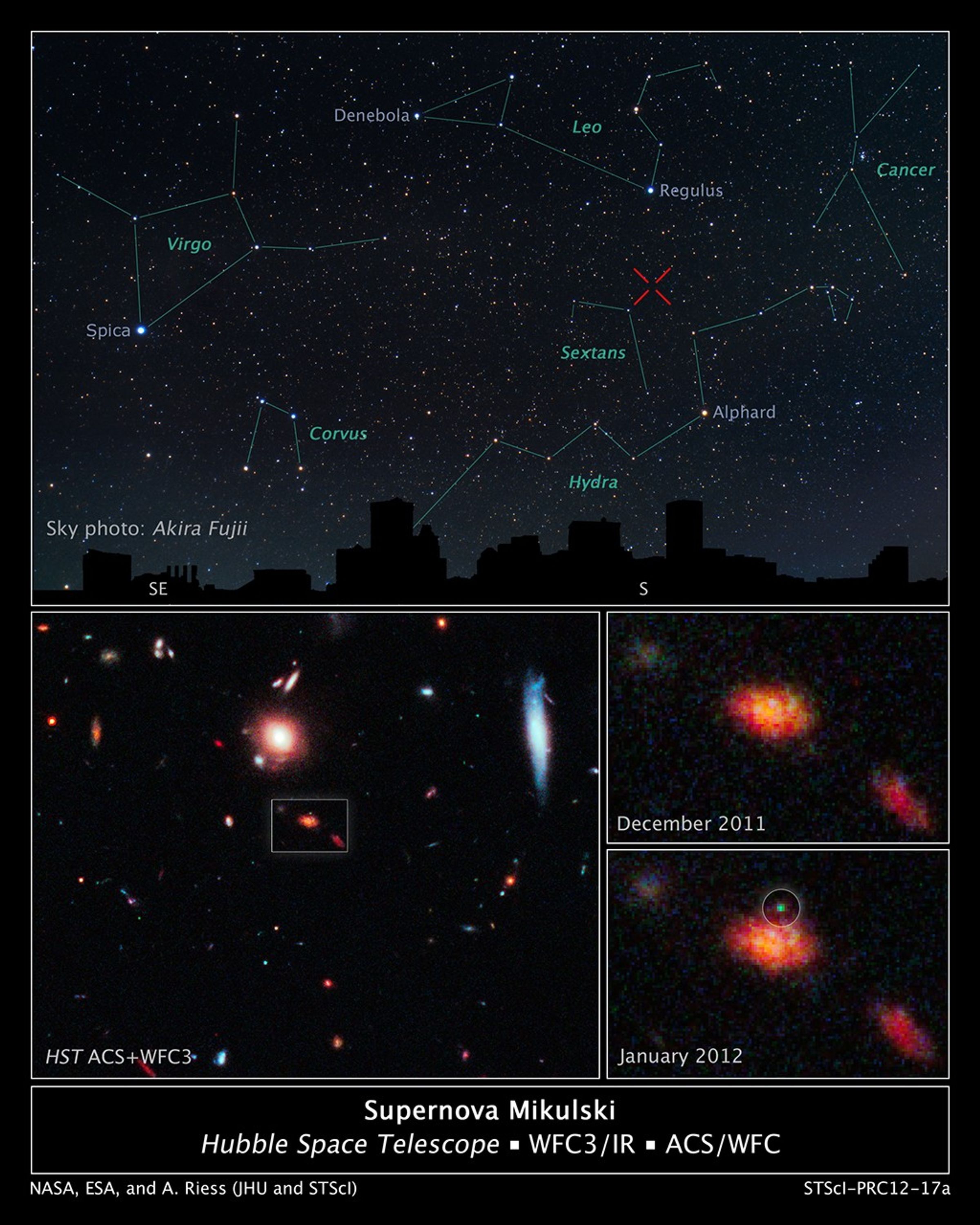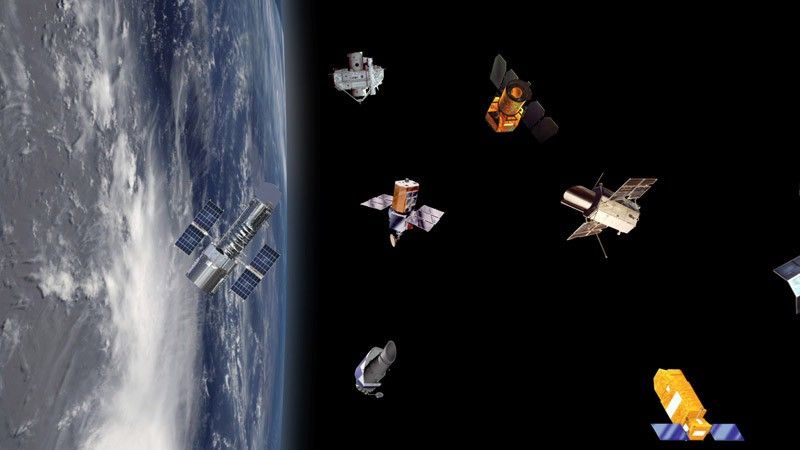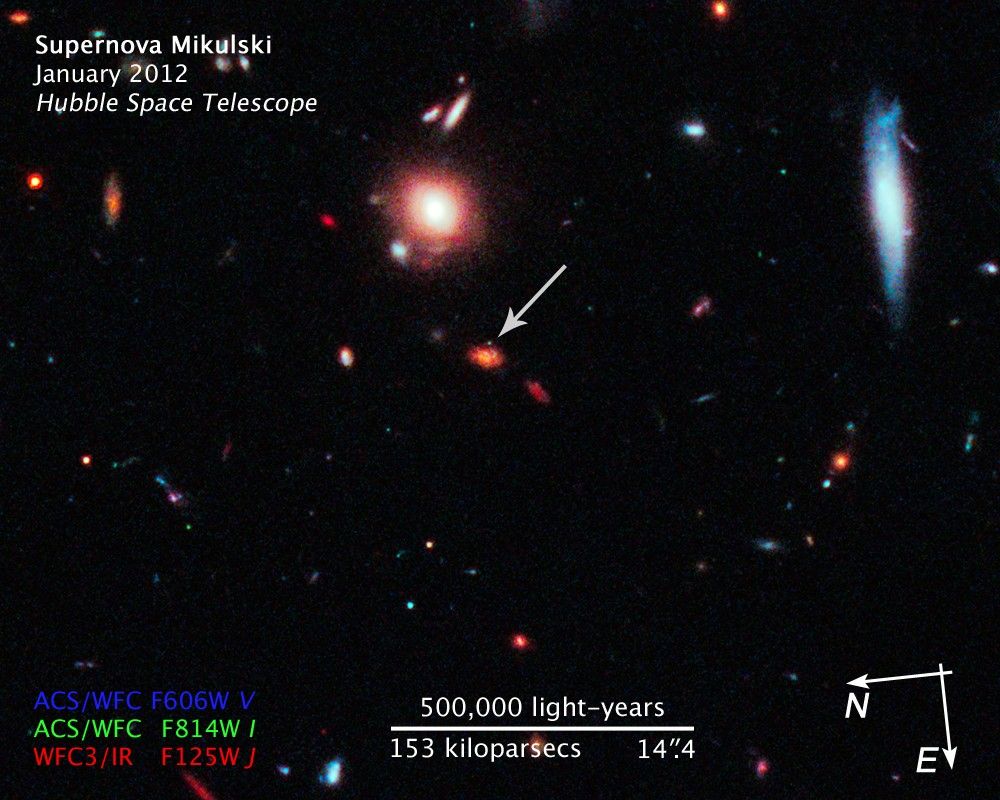1 min read
Supernova Mikulski

This panel of images reveals a newly discovered exploding star, the faraway galaxy in which it resides, and its location in the night sky over Baltimore, Md.
Named Supernova Mikulski, in honor of the United States Senator from Maryland Barbara A. Mikulski, the explosion was spotted Jan. 25, 2012, by Hubble's Wide Field Camera 3 and Advanced Camera for Surveys. The supernova, which lies 7.5 billion light-years away, is the death of a star more than eight times as massive as our Sun.
The top panel is a sky chart showing the location of the supernova in the night sky. The silhouette is the Baltimore skyline. Prominent constellations are labeled in green, with imaginary lines connecting the brightest stars, which are identified in blue text.
The red "X" marks the supernova's location in the constellation Sextans, between constellations Leo and Hydra. Supernova Mikulski cannot be seen in the night sky. Even at its brightest, the supernova could only be detected by a powerful telescope, such as Hubble, because it is so extremely far away. Its light, however, has now faded, and the exploding star is not visible with any instrument.
The Hubble image at bottom left shows the region in which the supernova was found. The white box pinpoints the supernova's home galaxy. The faraway galaxy is undergoing a burst of star formation.
The two Hubble close-up images at right show the galaxy before the supernova's glow is seen and just after it was spotted. The green dot in the image at bottom right reveals the supernova's location. Hubble began looking at the region in late November 2011 and observed the area for four months.
The three Hubble images are a blend of visible and near-infrared light.
Astronomers found the exploding star while using Hubble to take a census of the most distant stellar detonations. They are using the three-year survey called the CANDELS+CLASH Supernova Project to study regions targeted by two large Hubble programs: the Cosmic Assembly Near-infrared Deep Extragalactic Legacy Survey (CANDELS) and the Cluster Lensing and Supernova Survey with Hubble (CLASH). The project is led by Adam Riess of the Space Telescope Science Institute and The Johns Hopkins University, both in Baltimore, Md. Riess shared the 2011 Nobel Prize for Physics with two other astronomers for co-discovering that the universe is expanding at an ever-accelerating pace. The supernova was found in the CANDELS survey.
Astronomers hope the supernova will help them understand star formation in the early universe.
About the Object
- R.A. PositionR.A. PositionRight ascension – analogous to longitude – is one component of an object's position.10h 0m 31.66s
- Dec. PositionDec. PositionDeclination – analogous to latitude – is one component of an object's position.02° 26' 13.84"
- ConstellationConstellationOne of 88 recognized regions of the celestial sphere in which the object appears.Sextans
- DistanceDistanceThe physical distance from Earth to the astronomical object. Distances within our solar system are usually measured in Astronomical Units (AU). Distances between stars are usually measured in light-years. Interstellar distances can also be measured in parsecs.7.4 billion light-years (2.3 billion parsecs)
About the Data
- Data DescriptionData DescriptionProposal: A description of the observations, their scientific justification, and the links to the data available in the science archive.
Science Team: The astronomers who planned the observations and analyzed the data. "PI" refers to the Principal Investigator.The image was created from Hubble data from proposal 12440: S. Faber (University of California, Santa Cruz) and H. Ferguson (STScI) et al. - InstrumentInstrumentThe science instrument used to produce the data.HST>WFC3/IR and HST>ACS/WFC
- Exposure DatesExposure DatesThe date(s) that the telescope made its observations and the total exposure time.December 2011 and January 2012
- FiltersFiltersThe camera filters that were used in the science observations.WFC3/IR F125W (J), ACS/WFC F606W (V), and F814W (I)
- Object NameObject NameA name or catalog number that astronomers use to identify an astronomical object.SN Mikulski
- Object DescriptionObject DescriptionThe type of astronomical object.Supernova Discovered in Hubble CANDELS Data
- Release DateApril 5, 2012
- Science ReleaseSpace Astronomy Archive and Distant Supernova Are Named in Honor Of U.S. Senator Barbara A. Mikulski
- CreditNASA, ESA, Adam Riess (JHU, STScI)

This image is a composite of separate exposures acquired by the WFC3 and ACS instruments on HST. Several filters were used to sample broad wavelength ranges. The color results from assigning different hues (colors) to each monochromatic (grayscale) image associated with an individual filter. In this case, the assigned colors are: Red: F125W (J) Blue: F606W (V) Green: F814W (I)

Related Images & Videos

Mikulski Archive for Space Telescopes (MAST)
This video describes the Barbara A. Mikulski Archive for Space Telescopes (MAST), located at the Space Telescope Science Institute in Baltimore, Md. The archive holds data from 16 NASA telescopes, including current missions such as the Hubble Space Telescope and Kepler, a...
Share
Details
Claire Andreoli
NASA’s Goddard Space Flight Center
Greenbelt, Maryland
claire.andreoli@nasa.gov






































